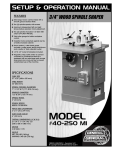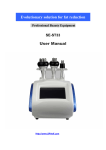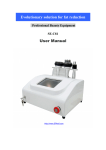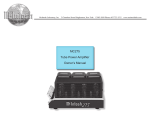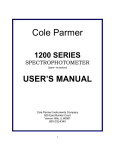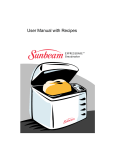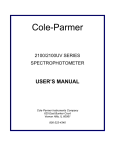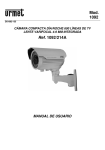Download MOTOR M1 5 HP, 220V, 1 PH 60HZ.25A WEIGHT 748 IBS (340 Kg
Transcript
Heavily ribbed, solid cast iron table with a smooth ground surface finish. Four(4) spindle speeds with reverse. Independently adjustable left and right industrial duty fences with precision fine-tune adjustment dials. Deluxe precision T-slot miter gauge for better workpiece control. 5HP industrial motor protected against dust by a totally enclosed cabinet. Magnetic switch with thermal overload protection. Quick release belt tensioning system for quick and easy speed changes. Built-in caster system for instant mobility within the shop. Large cutter guard with window, spring hold down and built-in 4” dust outlet. Convenient, extra large adjustment handles. MOTOR M1 5 HP, 220V, 1 PH 60HZ.25A WEIGHT 748 IBS (340 Kg) 14. Do not force the machine. It will do the job better and be safer at a rate for which it was designed. lighting is available. -. 15. Keep guards in place and in working order. If a guard must be removed for maintenance or cleaning make removed before turning power on. with three-prong plug, it should be plugged into a three-pole electrical receptacle. Never remove the third prong. before cutting. 19. Always disconnect tool before servicing and when changing accessories such as arbors or cutters. designed. 21. Hold material firmly against the table. contacted. GENERAL ® INTERNATIONAL guarantee All component parts of GENERAL INTERNATIONAL machinery are carefully inspected during all production stages and each machine is thoroughly Inspected upon completion of assembly. Because of quality, GENERAL INTERNATIONAL agrees to within a period of 24 months from date of purchase.ln order to obtain warrantee, all defective parts must be returned prepaid to GENERAL INTERNATIONAL MFG. Co Ltd. Repairs made without our written authorization voids all guarantees. 1 2 3 7 5 4 9 8 6 10 12 11 13 15 16 17 19 22 20 21 1. GUARD 2. FENCE 3. SAFETY GUARD 4. KNOB 5. SCREW KNOB 6. WASHER 7. RETAINER (L) 8. RETAINER (S) 9. PLATE GUARD 10. TENSION 11. WRENCH 12. BAR 13. MITER GAUGE 14. MITER GAUGE FENCE 15. SPINDLE 16. WRENCH 17. WRENCH 18. ADJUSTMENT HANDLE 19. KNOB 20. WRENCH 21. DRAWER BAR 22. WASHER 18 14 inspected before shipment and if properly used will give perfect results, However, a reasonable amount of care and attention is necessary to ensure perfect performance and accurate work. It is imperative that you take a few moments to familiarize yourself with these instructions, as they will no doubt save you a lot of UNPACKING AND CLEANUP and install it accurately before use. As soon as you receive the shaper, we recommend you follow these procedures: 1. Finish removing the contents of the shipping wooden case and compare with the contents list. 3. Clean all rust protected surfaces with a mild solvent or kerosene. Do not use lacquer thinner; paint thinner, or gasoline. These will damage painted surfaces. 4. To prevent rust, apply a light coating of paste wax to surface. INSTALLATION 1. Machine must be placed on a flat, solid surface. 2. Remove all foot bolts locking it to its shipping base before lifting machine. 4. Test machine length-wise and cross-wise before starting any operations. 5. Metal shims must be placed under low corners. 6. Once all four corners are supported, tighten lag screw, and retest machine in both directions. POWER CONNECTIONS The spindle shaper has been factory wired before shipment. Before connecting to the power source, verify that power outlet corresponds with the motor voltage. All electrical and motor wiring must be performed by a qualified electrician. This machine must be properly grounded while in use for protection against electrical shock. FIG.1 ELECTRICAL CONTROLS button, magnetic control system, and a reverse switch.(Fig. 1,2) A B C FIG.2 SPEED CHANGE AND BELT ADJUSTMENT FIG.3 A B Follow these procedures to change speed and adjust the proper belt tension. 1. Disconnect machine from power source. 2. Open guard door. C 4.Move the belt to the other groove (Fig. 3B) 5. Push handle bar (Fig. 3C) to get proper belt tension 6. Tighten the lock handle.(Fig. 3A) 7. Close guard door. SPINDLE RAISING AND LOWERING: (FIG. 4. 5) Procedures to adjust the main shaft in the up or down position. 1. Hand wheel (A) must be loosened. FIG.4 A ' 3. Hand wheel (A) must be tightened. SPINDLE CHANGE 1-1/4" spindle assemblies are supplied with your shaper. The assemblies are locked in a tapered seat with a draw bar and nut. CHANGING One wrench must be placed on the flats on top of he spindle and the second wrench on the draw bar nut (Fig. 6), this allows the spindle to Turn the nut two times; tap gently upwards with a wooden block, this will loosen the spindle from the aper. Remove nut and lift out the spindle. FIG.5 B FIG.6 CHANGING CUTTERS All spindle sizes are equipped with a safety lock nut, Lefth a n d t h r e a d s are found above the large spindle nut. (Fig.7) To mount or change cutter, first remove the safety lock nut. : Remove the spindle nut by placing one wrench on the spindle nut and another wrench on the flats on top of the spindle. Safety lock nut must be replaced before starting work operations. FIG.7 TABLE INSERT SPINDLE SAFETY LOCK NUT The second table insert has a guide shoulder of Ø 3-1/2", this table Insert is used for copying. : SPINDLE NUT SPACER ASSEMBLING AND INSTALLING SHAPER FENCE The fence can be assembled using the diagram (pg.22) as a guide. Fence installation: Once assembled, place the fence on the table. Lock it in place using the two-lock handles (A) and two-lock levers (B). (Fig.9) ( FIG.8 FIG.9 A B SQUARING THE FENCE Occasionally the aluminum fence will have to be squared with the mounting surface and adjusted parallel to each 2. The wing screw (C) should be tightened to hold the aluminum fence (B) securely. . The fence should now make contact with the jointed edge and square with the table. E FIG.10 A C D B OPERATING CONTROLS FOR THE FENCE Depending on the type of work you are shaping, either side of the fence can be moved freely. Fence can be moved by loosening wing screws (A),(Fig.11) Proper setting can be achieved by turning knob (B). The turning knob (B) is with scale for accurate setting. Wing screws (A) must be then tightened to fix in position. Each fence half should be adjusted as close to cutter head as possible. FIG12 FIG.11 A A B B WORK SAFETY HOLD DOWN ADJUSTMENT Loosen knob (A), turn tension plate to desired angle. Then tighten the bolt. (Fig. 13,14). A PROTECTION GUARD ADJUSTMENT (FIG. 15) FIG.15 1. Loosen two knobs (A) to slide protector to desired height. A PERIODICAL MAINTENANCE Experienced technician should be contacted when the ball bearings • Spindle must always be cleaned properly and with care, with the use of compressed air jet. • Make sure never to apply oil to the belts and the pulleys, clean with a dry soft rag to clean when greased or dirty. • V-belt must never be under excessive strain, this will cause the machine to overload and can damage the motor bearings, spindle and belt. FIG.16 FENCE ADJUSTMENT (FIG.16) The fence is fixed the position before shipment, following the instruction for when need to do the minor fence adjustment. 1. Loosen the screw (A) and adjust (B) set screw for adjusting the fence to proper position then tighten screw (A). (Pic.1) 2. Loosen the screw (A) and adjust (D) set screw for adjusting the fence to proper position then tighten screw (A). (Pic.2) 1. Loosen the screw (A) and adjust (E) set screw for adjusting the fence to proper position then tighten screw (A). (Pic.3) 2. Loosen the screw (A) and adjust (C) set screw for adjusting the fence to proper position then tighten screw (A). (Pic.4) Improper position D E C A fence B bracket fence bracket FIG.17 MACHINE LEVELING Shift the foot pedal (A) upward to allow the leveling screw (B) and four leveling screws located at the four bottoms to rest on the floor. Shift the foot pedal (A) downward to fixing the machine. Turn the four leveling screws by using open end wrench for adjusting the machine leveling. B A 1. Spacers, cutters and collars mounted on the spindle shaft must be in a fixed position. There must be no movement, space or touching between parts. 2. Counter bores and holes of collars, cutters or spacers must be in perfect condition with no rust or flaws. BEFORE OPERATING The main drive motor should run for a few seconds, to make sure that it is performing in the proper rotation. Looking down at the spindle, it should be rotating counter-clockwise this is the proper position. Machine should stay on for a short period of time to make sure that all moving parts are properly positioned with no excessive vibration. If any adjustments are required disconnect machine from the power source before properly adjusting. WARNING ! ALL WORK OPERATORS MUST READ AND UNDERSTAND THE MANUAL BEFORE STARTING ANY WORK OPERATIONS ON THE SHAPER ! « ATTENTION ! CUTTER ROTATION work piece must be fed from right to left. work piece must be fed from left to right. GRAIN DIRECTION The work piece should always be shaped in the same direction as the grain (if possible). When cut against the wood grain, woods as redwood, fir and oak will leave a rough, or slightly splintered edge. CAUTION: When deep cuts are required, they will need strong power and a pushing force in order to control the cut. Deep cuts can also cause the wood to split or splinter, this may lead to loss of control or injures to the work operator. When a finished edge is not to your satisfaction, cut a few more times with no more than 1/16" deep. Pre-cut stock on band saw 1/16" whenever possible. The trailing board edge will splinter when shaping across the grain. The best solution would be to cut the board 1 /4" oversize in width shape the board and simply trim off the excess. STRAIGHT EDGE SHAPING • The work piece must always be against the fence to perform straight edge shaping, follow these procedures to set up: 1. Disconnect machine from the power source. 2. Fence faces must be parallel, properly in line or offset If necessary, 3. Cutter must be rotated and inspected for clearance. 4. Position the leading face of a cutter head blade at 90 degrees to the infeed fence and adjust the spindle to the desired height of the cut. At the same time check the desired depth of cut with the blade in the 90 degrees position.(Fig. 20) DEPTH OF CUT The depth of cut is the distance from the outside circumference edge of the collar which the work rides against to the outside edge of the cutter. The depth of the cut is determined by the position of the fence relative to the cutter head or by the use of shaper collars. 1. Spindle must be locked. 2. Right guard should be installed wherever possible. 3. Connect to the power source. Note: To determine if the cut, profile and depth are correct you will only need a short cut. 5. Make adjustments if required, or proceed shaping using the work piece. EDGE SHAPING: LONG BOARDS The work piece must be at least 12 inches long when edge shaping long boards. 1. To hold work piece down and against the fence use the hold -downs and horizontal clamps. If the work piece is too wide for the horizontal clamps(Fig. 21), clamp a scrap board to the table to keep the work piece against the fence. 3. To make a smooth cut the work piece should be fed slowly and steadily with firm, even pressure. Note: The rate feed depends on depth of cut and experience of operator. EDGE SHAPING: SHORT BOARDS When edge shaping short boards, never attempt to hand guide any stock less than 12 inches long, or narrower than 3 inches without the use of a special guide (Fig. 22) END SHAPING When end shaping narrow stock at least one half of the work piece end must be in contact with either the outfeed or infeed fence. (Fig. 23) Warning: never attempt to shape a narrow piece without a special guide, the work piece may star rocking into the cutter head causing minor or major injury to the work operator. SHAPING SIDES When shaping across the grain, some woods are more likely to chip out or splinter. It is recommended to shape cross grain sides first. Any chipping that does occur will be removed by the subsequent cut with the grain. (Fig. 24). Using the existing bolts in the fence, attach a taller shop-made fence when the shaper fence does not support firmly support taller stock, (Fig. 25) Note: To avoid interference with mounting screw, make sure the bolt holes are on your shop-made tall fence are countersunk. SHAPING CONTOURED EDGES WITH RUB COLLARS To shape contoured edges the fence assembly should be removed. In order to control the work piece and limit the depth of cut an anti-friction collar must be used.(Fig, 26) The purpose of the collar is to ride against the work piece, collar can be positioned above or below the cutters. The ring guard should be used whenever possible. When work piece needs to be shaped alt around the perimeter, hold firmly and press the work straight into the cutter until the collar established depth of cut. While holding firmly, keep feeding the work so the point of contact on the edge is always 90 degrees to the collar. When work piece is not contoured all around, start the cut as shown in (Fig. 29). at least workplace WARNING i DEVISES. 12" AWAY FROM ANY CUTTING Small size materials need a special shaping jig. (Fig. 30) Remove entire fence assembly; place jig carefully at the desired depth of cut, clamp to table securely. It is important with arc and circle shapes that the work piece must be roughly cut to desired size and curve of the finished piece, before being shaped. The curve of the jig must match the work The work piece must be firmly attached to the jig. This operation should always be in use of a ring guard or a similar safety device over the cutter head. anti-friction collar ENCLOSED EDGE SHAPING Inside edge work piece are shaped the same way as outside edges (Fig.31). When the whole edge needs to be shaped, the operator must use The work piece must be placed on table before starting the motor. The operator must shape the whole work piece by feeding into the cutters. WARNING ! NEVER ATTEMPT TO PERFORM THIS PROCEDURE WITHOUT A RING GUARD OR A SIMILAR SAFETY DEVICE OVER CUTTERHEAD ! ATTENTION ! OPERATION MUST BE AWARE AT ALL TIMES OF THE FEED DIRECTION ! OPERATION MUST NOT BE LEFT UNATTENDED! 1. Use a firm grip to ease the edge into the cutters until stopped by the collar (Fig. 32). 2. Keep pushing straight while turning and feeding the work piece, continue until the cut the off position and remove the work piece only once the cutters have ATTENTION ! NEVER PERFORM ENCLOSED EDGE SHAPING WHEN THERE IS LESS THAN 12" OF WOOD MATERIAL ALL AROUND THEOPENING ! THE ONLY TIME THIS CAN BE DONE IS IF THE WORK PIECE IS ATTACHED TO A LARGER WOOD BASE! NEVER PERFORM ENCLOSED HAPING WHEN WORK PIECE OPENING IS MALLER THAN TWICE THE DIAMETER IN ANY DIRECTION TEMPLATES A template serves as guide for the cutter. The template must be made a collar, recommended size 3/4". (Fig. 33) MULTI-PIECED TEMPLATES workplace template SECURING A TEMPLATE TO THE WORK PIECE Various methods are used to secure template to the work piece. The operator should select the best method to secure the template to the work piece based on piece is large enough to surpass the front of table, while still leaving space for the desired cut. (Fig, 35) The work piece may be placed against the template using dowels as work piece through the cut. (Fig. 36) HORIZONTAL TOGGLE CLAMP Horizontal toggle clamp are useful when the regular "C" clamps cannot allow the freedom of movement required in shaping (Fig. 37). No additional hand pressure is necessary for the operator to control the work piece. Anchor points like dowels are necessary with this setup. PROTECTION workplace The operators should take precautions to protect themselves, and all others around the work area and the machine itself for improper use. Never leave machine unattended while it is running, the operator needs to be very focused and attentive, and not looking elsewhere or carrying on conversation while using the machine. Carelessness or inattention will result in serious injuries and damages. SPECIAL CUTS the cutters. The most efficient cutters are carbide tipped to ensure cleaner cuts and longer cutter life. Small cutters may be solid carbide, some use inserts. Since there is such various choices, the operator is limited only cutter STACKED CUTTERS A variety of timesaving and interesting cuts can be made in a single setup by stacking the cutters (Fig. 39). When stacking cutters extra care should be taken. Check that cutters have no flaw nicks, or just. Cutters must cleaned and perfectly balanced before placing in the stacked poisiton. SASH AND DOOR SHAPING cutter stock groove cutter Door shaping requires two operations. (Fig. 39) demonstrates sash cut for the first operation. Figures 40 demonstrates when the stock is flipped over and the sash cutter with a 1/4" groove cutter to complete the cut. Figure 41 demonstrates the first shaping cut with the sash cutter for the matching door stile sash. Figure 42 demonstrates the same cut with the stock flipped over. Figure 43 demonstrates the first shaping out, for a window sash stile using a sash cutter, collar, and a 1/2" groove cutter Figure 44 demonstrates both cuts needed tion at top is a rabbet cut made with a groove cutter. The second operation is performed with a stub spindle and button head screw. BUTT JOINTS All butt type joints require both work pieces to be perfectly squared and inline and adjusted for a depth of cut (Fig. 45). both cuts on the work pieces are partedge cuts that do not reduce the width of material during cutting procedures. When shaping the work pieces, one must be ted top-side up, and the other is fed bottom-side up. the tongued joint and must be adjusted for 1/4" depth of cut with no reduction in stock width. With this joints, both work pieces are fed with Leaf Bead cutter, the table work piece is shaped with d Drop Leaf Cove cutter. This joint type, the whole edge of both work pieces are shaped the same side up and allows 1/16" reduction in width. Adjust the infeed fence to reduce the work piece width by 1/16" and adjust the outfeed-fence to compensate for stock removed. (Fig. 47) TENONING Figure 48 demonstrates the tenoning fixture which shows a miter gauge equipped with a hold-down for shaping the ends of narrow work piece. A Miter gauge can also be adapted to cut square and centered tenons at the ends of leg for table, chairs etc. Secure leg to the jig and position for cut (Fig. 49). First cuts must be made with the same jig setting and spindle height. When the first several cuts have been made, reposition the leg on the jig for each succeeding cut. Note: If legs are tapered. (Fig.50) use a wedge to set the side facing the cutter to 90 degrees vertical. BASE PARTS LIST 40-350 DESCRIPTION 40350-1 40350-2 40350-3 40350-4 40350-5 40350-6 40350-7 40350-8 40350-9 40350-10 40350-11 40350-12 40350-13 40350-14 40350-15 40350-16 40350-17 40350-18 40350-19 40350-20 40350-21 40350-22 40350-23 40350-24 40350-25 40350-26 40350-27 40350-28 40350-29 40350-30 40350-31 40350-32 40350-33 40350-34 40350-35 40350-36 40350-37 40350-38 40350-39 40350-40 40350-41 40350-42 TABLE INSERT TABLE INSERT TABLE INSERT SET SCREW CAP TABLE WASHER SPRING WASHER SCREW STAND ASSEMBLY BASE SCREW POWER LIGHT FORWARD SWITCH REVERSE SWITCH EMERGENCY STOP WHEEL BRACKET NUT NUT SPRING WASHER WHEEL SCREW SCREW CAP WIRE PROTECTOR ELECTRIC CORD SIDE DOOR LOCK SCREW SCREW WIRE PROTECTOR SCREW CONNECTOR BOX NUT 1/4" SPRING WASHER SCREW BRACKET SCREW GUARD SCREW BACK DOOR FOOT PEDAL WHEELS PIN DOOR LOCK SPECIFICATION PT 5/16" X 5/8" 30" X 40" X 85mm 3/8" 3/8" 3/8" X 1 3/16" X 1/2" 5/16" 5/16" 5/6" X 1" 5/16" X 2-1/2" 3/8" X 1-1/4" 1/2 1/4" X 1" 3/16" X 1/2" 3/16" X 1/2"L QTY 1 1 1 3 1 4 4 4 1 1 2 1 1 1 1 1 2 4 4 2 4 2 1 1 1 1 4 4 2 4 1 4 4 4 1 2 1 2 1 1 2 1 BASE PART N0. QUILL PARTS LIST 40-350 DESCRIPTION 40350-43 40350-44 40350-45 40350-46 40350-47 40350-48 40350-49 40350-50 SCREW SPRING WASHER 1/4" WASHER 1/4" HAND WHEEL LOCK SHAFT NUT SCREW LOCK SCREW GEAR SPECIFICATION 1/4" X 1" 5/16" 5/16" X 3/4" QTY 1 1 1 1 1 1 1 1 QUILL PART N0. PARTS LIST 40-350 DESCRIPTION 40350-51 40350-52 40350-53 40350-54 40350-55 40350-56 40350-57 40350-58 40350-59 40350-60 40350-61 40350-62 40350-63 40350-64 40350-65 40350-66 40350-67 40350-68 40350-69 40350-70 40350-71 40350-72 40350-73 40350-74 40350-75 40350-76 40350-77 40350-78 40350-79 40350-80 40350-81 40350-82 40350-83 40350-84 40350-85 40350-86 40350-87 40350-88 40350-89 40350-90 40350-91 40350-92 40350-93 40350-94 40350-95 40350-96 40350-97 40350-98 40350-99 40350-100 40350-101 40350-102 40350-103 WASHER GEAR SCREW SCREW NUT SPRING WASHER WASHER KNOB HAND WHEEL BASE GEAR FOR SHAFT GEAR SHAFT SCREW NUT SCREW NUT SHAFT NUT WASHER PLATE WASHER NUT MOTOR BASE BELT SCREW SPRING WASHER WASHER SCREW POINTER NUT SPRING WASHER WASHER NUT SCREW SCREW SPRING WASHER ELECTRIC CORD FOR MOTOR BRAKE SCREW MOTOR MOTOR BASE KNOB MOTOR PULLEY WASHER SPRING WASHER HANDLE LOCK COLLAR NUT SCREW SCREW NUT SPINDLE BASE GEAR SHAFT KEY COLLAR SPECIFICATION QTY 5/16" X 1" 5/16" X 1" 5/16" 5/16" 5/16" 5/16" X 3/4" 5/16" 1/2" X 1" 1/2" 3/8" 3/8" A-25 1/4" X 1/2" 1/4" 1/4" 5mm X 0 X 8 mm X 8mm 5/16" 5/16" 5/16" 1/2" 1/2" X 1-1/4" 5/16" X 3/4" 5/16" 5/16" X 5/8" 3/8" 3/8" 3/8" 3/8" X 1" 3/8" 1-1/4 1/2" 5mm X 5mm X 15mm 1 1 1 2 2 2 2 1 1 1 1 1 1 1 1 1 1 1 1 1 1 1 2 2 2 1 1 4 4 4 1 1 4 4 1 4 1 1 1 1 2 5 1 1 2 2 1 2 1 1 1 1 QUILL PART N0. FENCE PARTS LIST 40-350 DESCRIPTION 40350-104 40350-105 40350-106 40350-107 40350-108 40350-109 40350-110 SCREW HANDLE LOCK WASHER BRACKET ASSY FENCE SCREW(T) BAR(L) COUNTERSUNK SETSCREW QTY 1 1 1 1 1 1 1 FENCE PART N0. PARTS LIST 40-350 DESCRIPTION 40350-111 40350-112 40350-113 40350-114 40350-115 40350-116 40350-117 40350-118 40350-119 40350-120 40350-121 40350-122 40350-123 40350-124 40350-125 40350-126 40350-127 40350-128 40350-129 40350-130 40350-131 40350-132 40350-133 40350-134 40350-135 40350-136 40350-137 40350-138 40350-139 40350-140 40350-141 40350-142 40350-143 40350-144 40350-145 40350-146 40350-147 40350-148 40350-149 40350-150 40350-151 40350-152 40350-153 40350-154 40350-155 40350-156 40350-157 40350-158 40350-159 40350-160 40350-161 40350-162 40350-163 40350-164 40350-165 40350-166 SET FENCE KNOB SCREW KNOB RETAINER KNOB SHAFT KNOB LOCK KNOB HANDLE LOCK T-HEX NUT SPRING TENSION KNOB SCREW LOCATING PLATE GUIDE BAR WASHER MITER GAUGE BODY WASHER NUT SCREW ROLLER GUIDE FLAT HEAD SCREW FENCE SCREW HANDLE SPRING TENSION SET SCREW COUNTERSUNK SETSCREW SCREW(T) BRACKET ASSY FENCE WASHER HANDLE LOCK SCREW BAR GUARD PROTECTING GUARD KNOB SEE-THROUGH GUARD WASHER KNOB WING SCREW WASHER KNOB SCREW KNOB SCREW WASHER SET SCREW KNOB SCREW ROD WING SCREW KNOB WASHER SCREW ROD KNOB SET SCREW SPECIFICATION 3/8" 3/16"X3/4" 3/16"X1/4" 5/16"X1-3/4" QTY 4 2 1 4 1 2 1 2 1 2 2 2 2 2 1 1 1 2 1 1 3 3 1 1 1 2 1 2 4 1 1 1 1 1 1 1 1 1 1 1 1 1 1 1 1 1 1 1 1 1 1 1 1 1 1 1 FENCE PART N0. SPINDLE SPINDLE PARTS LIST 40-350 PART N0. DESCRIPTION 40350-167 40350-168 40350-169 40350-170 40350-171 40350-172 40350-173 40350-174 40350-175 40350-176 40350-177 40350-178 40350-179 40350-180 40350-181 40350-182 40350-183 40350-184 40350-185 40350-186 LOCK BOLT LOCK NUT BEARING SNAP RING SPINDLE PULLEY LOCK WASHER LOCK NUT BEARING BEARING QUILL SPINDLE SHAFT KEY COLLAR COLLAR HEX NUT HEX NUT COLLAR COLLAR COLLAR SPECIFICATION S-30 1-1/4" 1-1/4" X 3/4" 1-1/4" X 1" 3/4" RXH 1" RXH 1-1/4" X 1/4" 1-1/4" X 3/8" 1-1/4" X 1/2" QTY 1 1 1 1 1 1 1 1 1 1 1 1 1 2 2 1 1 1 1 2























